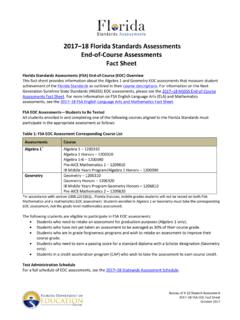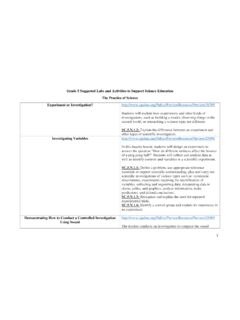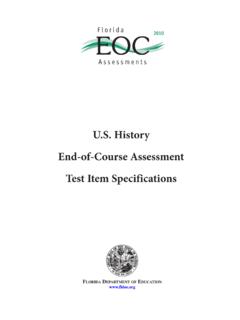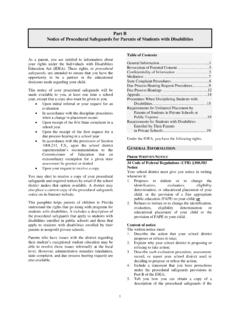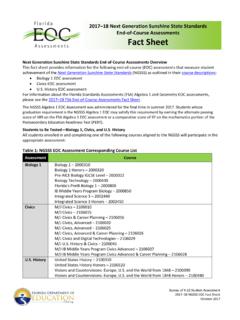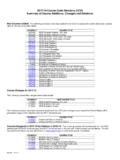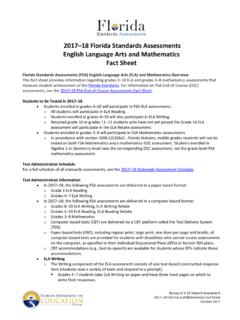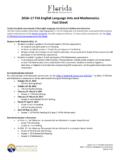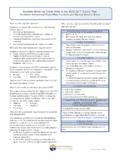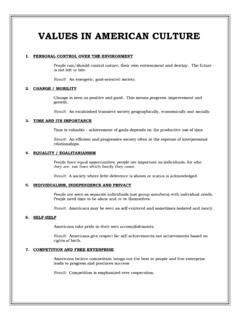Transcription of B.E.S.T. Standards Overview - Florida Department of Education
1 Standards OverviewJuly 20, 2020 Presentation outlineExecutive Order 19-32 History of Standards in FloridaTimelineBenchmarks for Excellent Student Thinking ( ) 1 Executive Order 19-32 Governor Ron DeSantis directed that by January 1, 2020, the Commissioner of Education shall comprehensively review Florida s Kindergarten through grade twelve academic Standards and provide recommended revisions to the governor. Sometimes confused with Standards , curriculum is the means or the instructional material by which the Standards are are the Standards incorporatedinto the classroom?Instruction is the teacher s delivery and strategies used to implement the curriculumand is instruction a part of the Standards ?
2 Assessments provide feedback to teachers, parents and students on a student s level of mastery of the are assessments relatedTo the Standards ?The Standards are student-centered expectations from which all curriculum, instruction and assessments are based. The Standards are what the state has are the Standards ?History of statewide student Standards in Florida19962005-2007201020142020 Sunshine StateStandardsNext GenerationSunshine StateStandardsNext GenerationSunshine StateStandardsIn English language arts & math(Common Core) Florida StandardsIn ELA & mathReviewThe Standards were created by Florida educators for Florida students.
3 Key differencesBetween current Florida Standards and StandardsEliminated Common CoreContent-RichBack-to-basics building a foundation at early gradesUnderstandable for teachers, parents and studentsCreated by Florida experts including 80+ FL-based teacher & stakeholder groupsFlexibility for teachers with a focus on great contentImproves rigor across all gradesDevelopmentally appropriate course contentActionable solutions for the reduction of testingConcise Standards to set clear expectations for students, teachers and parentsClear expectations for progression year to year through great course alignmentFirst in nation with civics booklist in ELA standardsFlorida s Standards for English Language Arts (ELA) 12 Literacy is achievablethrough content-rich instruction rather than merely through a skills-based approach to reading comprehension.
4 Explicit, systematic phonics instruction is the foundation of literacy. Decoding and fluency are essential to creating proficient readers. Reading comprehension depends more on relevant background knowledge than on mastery of reading strategies. Benchmarks, clarifications, and appendices represent the expected outcomes and are designed to be user-friendly. Reading and writing Standards are intertwinedutilizing accompanying text lists at every grade. *ELA Standards IntroductionELA Standards emphasize that: 13 Stackable Benchmarks ELA Expectations Benchmark Clarifications Literary Time Periods Booklist (ELA) Civics Booklist Rhetoric (starting in 6th) Reasoning Reading and Writing Connection Comprehensive Glossary14 ELA Coding :F FoundationsR ReadingC CommunicationV VocabularyEE ELA ExpectationsSubject CodeStrandBenchmarkGrade LevelELA evidence to explain and justify reasoning.
5 And comprehend grade-level complex texts proficiently. inferencesto support comprehension. appropriate collaborative techniques and active listening skills when engaging in discussions in a variety of situations. accepted rules governing a specific format to create quality work. appropriate voice and tone when speaking or Expectations 17 Benchmarks and Clarifications : Compare two or more themes and their development throughout a literary Clarifications:Clarification 1: For the purposes of this benchmark, theme is not a one-or two-word topic, but a complete thought that communicates the author s 2:Students should continue to work with the concept of universal themes, although mastery isn t expected until 9th grade.
6 A universal theme is an idea that applies to anyone, anywhere, regardless of cultural differences. Examples include but are not limited to an individual s or a community s confrontation with nature; an individual s struggle toward understanding, awareness, and/or spiritual enlightenment; the tension between the ideal and the real; the conflict between human beings and advancements in technology/science; the impact of the past on the present; the inevitability of fate; the struggle for equality; and the loss of Periods Classical (1200 BCE 455 CE) Medieval (455 CE 1485 CE) Renaissance (1300 1660) Restoration and 18th Century (1660-1790) Colonial and Early National (1600-1830) Romantic (1790-1870) Realism and Naturalism (1870-1910) Modernist (1910-1945) Contemporary (1945-Present)20 Secondary Foundational Standards Phonological Awareness Phonics and Word Analysis Encoding Fluency*Secondary foundational Standards will only appear in elective remedial reading course Contact22 Just Read, Florida !
7 Rebecca Mead Email: Phone: 850-245-5060 Carey Sweet Email: Phone: 850-245-9539 Florida s Standards for K-12 Mathematics The Standards are clear and concise, so they are easily understood by all stakeholders Benchmarks should not stand alone as separate content for instruction but should be combined purposefully Appropriate progression of content within the grade level/course and across grade levels/courses 9-12 Benchmarks written to support multiple pathways for success in career and college for students Background Progression of content across strands is purposeful so benchmarks are not taught in isolation Intentional balance of conceptual understanding and procedural fluency Written to allow teachers to meet students' individual skills.
8 Knowledge and ability Real-world applications intertwined within concepts for relevance Maintain high expectations for Florida s students, ensuring equity and access for allEmphasis of Benchmarks Benchmark clarifications Benchmark examples Consistency of strands from Kindergarten to high school Introduction of a standard algorithm for division in grade 5 Financial literacy embedded within K-8 and specific strand within 9-12 K-12 glossaryCoding Level(s)BenchmarkStandardSubject CodeStrand Number Sense and Operations (NSO) Measurement (M) Fractions (FR) Trigonometry (T) Algebraic Reasoning (AR) Data Analysis and Probability (DP) Functions (F) Logic and Discrete Theory (LT) Financial Literacy (FL) Calculus (C) Geometric Reasoning (GR) Mathematical Thinking and Reasoning (MTR)
9 Progression of Strands Developed so that educators will teach through the lens of the MTRs incorporates understanding through models, multiple methods, discussions and applications to real-world Language of MTRs written as self-monitoring tools for students Language of MTR clarifications written to provide guidance to all stakeholders on how to integrate MTRs into instructionMathematical Thinking & Reasoning Standards (MTRs) Actively participate in effortful learning both individually and with others. Demonstrate understanding by representing problems in multiple ways. Complete tasks with mathematical fluency.
10 Engage in discussions that reflect on the mathematical thinking of self and others. Use patterns and structure to help understand and connect mathematical concepts. Assess the reasonableness of solutions. Apply mathematics to real-world : Because Math MattersBenchmark Clarifications Support instruction ( , different methods, conceptual understanding, etc.) Provide extent of which benchmark should be taught Provide examples of expectations Provide connections to previous and extended knowledge References to appendices 32 Provide sample questions that could be used as tasks within the classroom Provide methods a student could solve a problemBenchmark Involving Operations and Automaticity Glossary of Operations, Equality and Inequality FormulasAppendices 34 Contact35 Bureau of Standards and Instructional Support PJ Duncan, Director of STEAM Email : Ashley Harvey, Elementary Mathematics Specialist Email.
